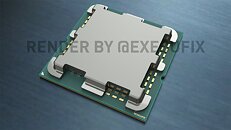Monday, June 7th 2021

AMD Raphael CPU IHS Features Cutouts for Capacitors
Last week,we have covered the leak of AMD's upcoming Raphael processor integrated heat spreader (IHS), which featured a rather unique design. While we have made speculations as to why the design was made like that, it seems that we now have an answer to the question. It was previously believed that the unique IHS design was there to protect a double-substrate design, like Intel designed with Skylake-X. However, thanks to the updated design by ExecutableFix, we now know that AMD's design choice for Raphael is based on the simple fact that the IHS needs those cutouts for capacitors, as this seems to be the only place to have them.
As you can see below, there was no room on the LGA side, where the LGA pads are placed, and a lot of speculation suggested that capacitors were placed under the IHS or in IHS cutouts. The latter has proven to be the case according to this leak. You can check out some of the updated renderings in the images below.
Source:
ExecutableFix (Twitter)
As you can see below, there was no room on the LGA side, where the LGA pads are placed, and a lot of speculation suggested that capacitors were placed under the IHS or in IHS cutouts. The latter has proven to be the case according to this leak. You can check out some of the updated renderings in the images below.



21 Comments on AMD Raphael CPU IHS Features Cutouts for Capacitors
Applying Liquid Metal as TIM will be challenging without using proper protection like isolating paint something like this Thermal Grizzly TG Shield:
www.thermal-grizzly.com/en/products/385-tg-shield-en
Absolutely nothing suggests otherwise.
as for using conductive tim on top, nothing has changed, it’s fatal anyway if something drips onto the motherboard. Now it can also drip to the cpu itself, but the difference is very minor in terms of over applying.
EDIT: On the other hand, the IHS has lost a little bit of mass, ...Hmmm
If they made the whole package a couple of millimetres larger, then the caps would have fit under the IHS. Remember, AMD just designed this new socket themselves. I personally think this is a design oversight.